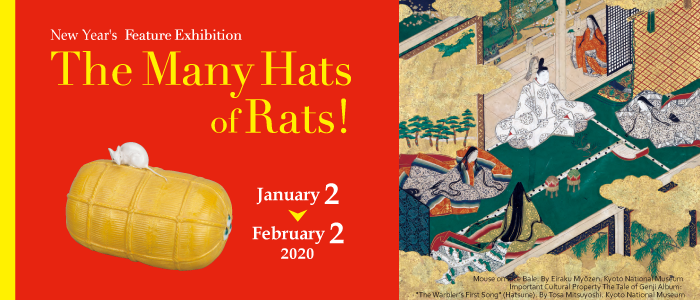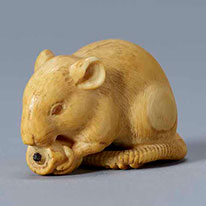General Information
| Exhibition Title | New Year's Feature Exhibition The Many Hats of Rats! |
|---|---|
| Period | January 2 – February 2, 2020 |
| Venue | Heisei Chishinkan Wing (The Collections Galleries), Gallery 1F-5 |
| Transportation | JR, Kintetsu Railway, Keihan Railway, Hankyu Railway, City Bus / Map |
| Closed | Closed on Monday *The museum will be opened on Mondays January 13, 2020 and closed on Tuesdays January 14, 2020. |
| Museum Hours | Tuesday - Thursday, Sunday: 9:30 a.m.–5:00 p.m. (Entrance Until 4:30 p.m.)
Fridays and Saturdays: 9:30 a.m.–8:00 p.m. (Entrance until 7:30 p.m.) |
| Admission |
Adult 520 yen (410 yen) Univ. Student 260 yen (210 yen) *Fees in parentheses are for groups of 20+ *Admission is free for high school students and other youths age 0–17, seniors over 70, visitors with disabilities and one caretaker, and for Campus Members (including faculty). Please show I.D. |
Images from the Exhibit
2020 is the Year of the Rat according to the Chinese zodiac. In fact,
the rat is the first animal in the twelve-year cycle. Why are rats and
mice, which are more commonly thought of as pesky varmints
portrayed so positively on works of art?
In Japan, the mouse (rat) has been regarded as a divine messenger
making it an auspicious animal. Originally, the mouse was associated
with the deity Ōkuninushi, since Japanese myths tell that a mouse
saved this deity's life. When Daikoku, the god of wealth with Hindu
origins, was brought into Japan, he was identified with Ōkuninushi
because the Chinese characters for Ōkuni could also be pronounced
"Daikoku." Hence the mouse became the messenger of this syncretic
god. In addition, mice are prolific breeders, making them a symbol of
fertility. Moreover, during the Edo period (1615–1868), rats and
mice were popular pets. Manuals on breeding rare species were
widely circulated and produced some calm rats and mice that
like people. In the Japanese court, a New Year's event to bolster
longevity was held on the First Day of the Rat (hatsune). This is
elegantly described in "The Warbler's First Song" (Hatsune), a
well-known chapter from The Tale of Genji (11th c.), which itself
inspired numerous celebratory artistic motifs.
This exhibition celebrates the New Year with outstanding
representations of this robust yet charming creature.
The gallery room is:
1F-2













